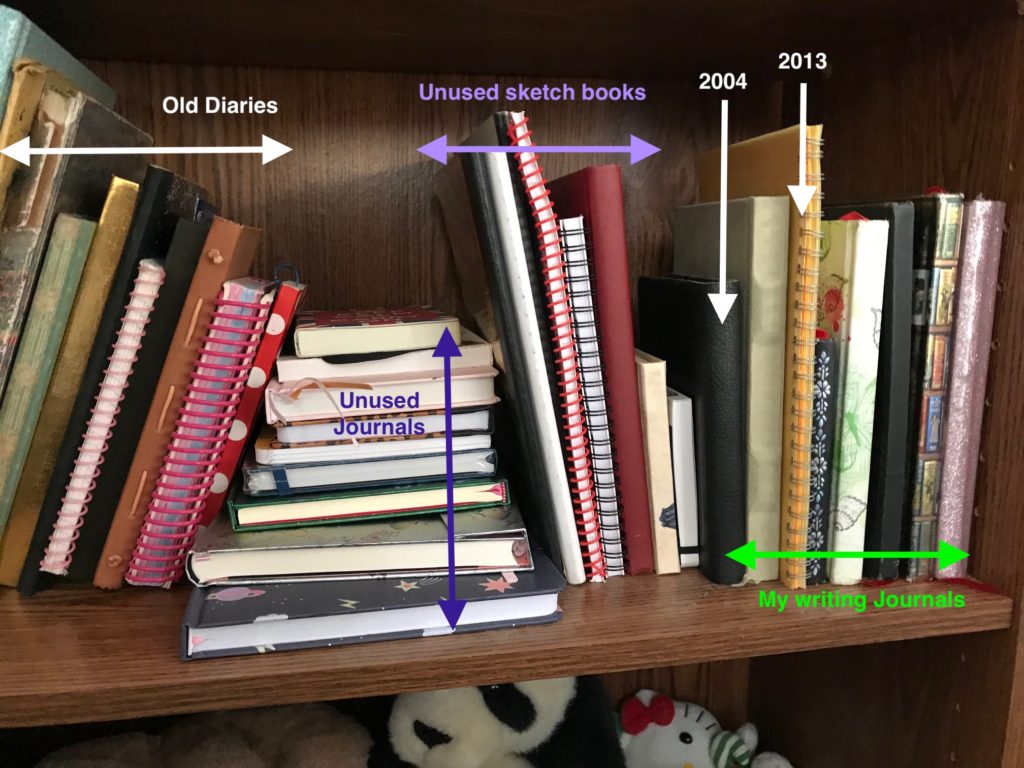I started keeping a journal in sixth grade English class. I still have that much-doodled yellow folder. There’s a certain lack of candor in it, not knowing how to say exactly how I feel yet. It was a dark time in my life, but you wouldn’t know it from the entries on loving pizza and bicycles.
From that first journal until 2004, I sporadically started diaries without ever filling any. I got a diary as a 16th Birthday present, and kept it dutifully for almost a year. I kept a diary as a college freshman right up until my first ex-boyfriend read it.
In 2004, I was working at CWRU and used my tuition waver to take “Advanced Creative Writing: the Novel.” The professor, Mary Grimm, assigned us to keep a journal about our novel throughout the course. This was a watershed moment for me and journalling. I bought a soft leather bound book and kept it religiously throughout the course. The last entry in the journal is from January of 2007 and notes that a literary agent had requested the first three chapters. (Ah me! I wish I still had the query letter that worked. I know I rather gave up on the novel after that agent turned it down and I’m just back to submitting it around again. I digress.)
The thing is, the journal helped me work on the novel. I completed the novel just a little past the end of the class. I was able to work out problems I was having with structure, free write ideas that wouldn’t necessarily work, and make plans for what I was writing when. I rushed out and bought another blank book to take notes on the next novel I wrote. That novel… and the journalling… didn’t go quite as well. But I was writing about writing regularly when I went to Clarion in 2013 and brought a slim yellow spiral notebook with me to take notes. (It had started out as a poetry journal, successor to 3 or 4 half-filled poetry journals before it.)
Since Clarion, I have never stopped journalling. I dare say the longest I’ve gone without writing an entry since then is, like, a week. Maybe two weeks if I was in the hospital or something. My Clarion notebook ran out of pages on the last day. It was kismet. I made the last page a list of what to fix on my six Clarion short stories after I got home.
When I got home, I immediately chose a beautiful (and very small) blank book from the stack of pretty blank books I’d purchased and I set myself some RULES. I would make check boxes for To Do items and use an arrow to mark Story Ideas. I kept a bookmark on the last unchecked to-do item so I was always aware of it. I limited to-dos to things that were concrete, measurable, and preferably things that could be done in a single sitting. These are my journalling rules to this day.

This week I sat down and I organized my shelf of journals, separating out the nine unused blank books that had been jumbled in with them (and the four blank sketch books which were mostly gifts and ok there are two composition books with the sketch books that were both “writing journals” started at some point, undated, with only 3-4 pages filled so I’m holding on to them to use.)
My love of journalling is outmatched by my love of buying pretty blank books. I’m glad I took stock because I almost bought myself a new one just the other day. (NINE!! and that’s not counting the unlined sketch books!)
I average a journal a year. Ish. I’m near the end of my current one, and will probably finish it off by March. Every journal since that tiny black and silver one, I start the first page with a transfer of all un-checked checkboxes from the previous journal. I’m pleased to say I never have more than a single page list. My most recent one I only had 4! Sometimes I write down how many checkboxes were checked in the whole journal. I write the end-date in the front under the start-date. There’s a RITUAL.
The thing that struck me, organizing my shelf, was how I struggled from 1986 to 2013, over and over writing “I will keep a daily journal from now on” in a new book only to give it up after a month or less. It’s a marvel to look back on something you used to do poorly and now do well. It took two steps. Mary Grimm’s class showed me how useful it could be. Clarion, an experience I wanted to capture for ever, gave me a reason to write every day, and by the end of six weeks of writing every day, I had made it a habit and I never let it stop.
My writing journal is a strong organizational tool. I read over it. I go back and see ideas. I write down deadlines and outlines and jot quick notes to deal with later. When I’m grocery shopping and think “Oh! She should hide the murder weapon in a cake!” I can whip the book out and draw a check box with “Hide murder weapon in a cake” next to it, and when I next have time to write, there is the idea waiting for me. It’s so handy.
I don’t know if I’ll ever re-read all these old journals. Some of my handwriting is abysmal, but I love having them, glancing at them. When I’m blocked, a few minutes writing in my journal loosens me ups and oils the machinery. I guess I’m saying I recommend it.


